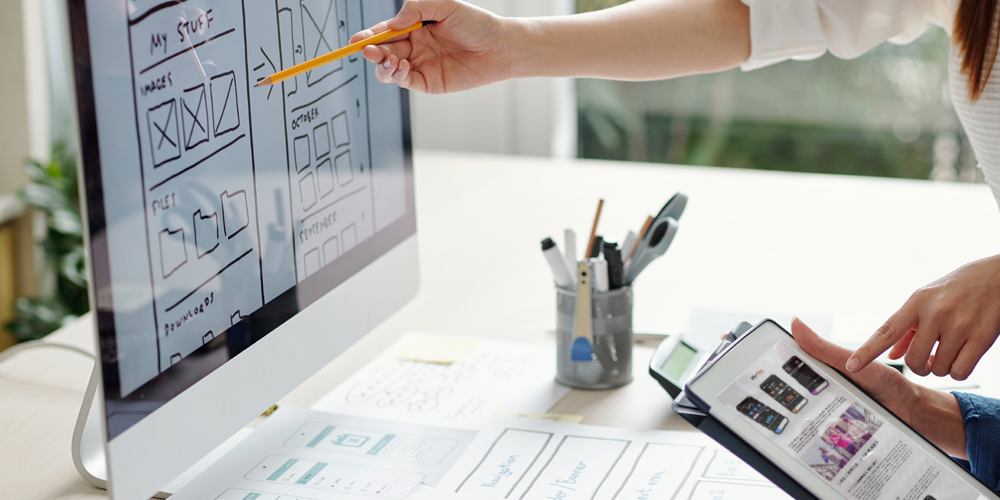Agile methodology has gained increasing popularity amongst software development teams over the past few years, and it’s easy to see why: it’s all about speed, flexibility, and efficiency. While Agile methodology can be challenging to get your head around at first, it’s one of the most widely used frameworks in software development today. It has been proven effective across numerous business sectors and industries.
Suppose you’re wondering how Agile can apply to your life as a UX designer. In that case, this article might help you understand how to incorporate Agile principles into your design process and work effectively with project managers, developers, clients, and other stakeholders in your projects.
Diving deeper into agile methodology
Agile methodologies are a group of software development methodologies based on iterative and incremental development, where requirements and solutions evolve through collaboration between self-organizing cross-functional teams. Teams work in short timeframes (sprints) that generally last from one to four weeks each. At the beginning of each sprint, stakeholders and team members collaborate to plan out a feature or set of features they want to develop next. Those features may be estimated using story points that indicate how difficult building them will be; once an agreed-upon amount of story points has been committed to a particular sprint, teams will begin making them. Within each sprint, all team members are expected to integrate their tasks with those completed by other members; integration testing begins once development begins.
Benefits of agile methods
You’ll find rapid iteration to be a common thread between all agile methodologies. Mainly because it can help reduce project risk and improve efficiency as you build a platform that’s right for your customers. And, because of how you typically operate within agile methods, there’s no need to wait until your project is complete before getting input from users—you can get feedback from them at any point in your process via surveys, usability tests, or A/B testing.
Agile processes encourage interaction and collaboration between team members, creating a more substantial product in less time. As a result, many companies are now incorporating some agile methodology within their organizational structure—and user experience designers should be among them. User experience designers can benefit from agile methods in several ways: by creating wireframes, developing test plans, and setting clear goals to meet deadlines, they will provide value to their business teams while still maintaining an environment that allows them to create top-quality products.
How do you start?
First and foremost, you need to define your MVP (Minimal Viable Product) and understand your client’s needs. This can sometimes be a difficult decision, and there are many different approaches; it’s a judgment call that only you can make. The answers will vary from project to project, but it’s essential to identify your client’s or stakeholders’ needs. It will ensure that you design a user experience that hits all of their core requirements. After all, if you can’t accurately predict what your client or stakeholder needs from you, how can you design a product that meets those demands. However, once you have your MVP decided, you should begin collecting feedback from users on what works and what doesn’t.
What happens in a sprint?
The sprints allow you to break down a long-term project into short, manageable tasks. In each sprint, you will deliver something of value—whether it’s working software or a user story that can be demonstrated or tested by your team members and clients. For example, in one week, you might improve an existing interface or create one entirely new interface. During every iteration, there are stand-up meetings where your team meets to discuss their progress or roadblocks/impediments.
Sprints usually run for 1-4 weeks. At the end of each sprint, all team members review their work and come to a consensus on what they’ve accomplished (and what they haven’t), then discuss whether they feel they need to do anything differently moving forward. This planning often results in another sprint with other user stories—or backlog items—that make up its focus.
What if I have questions during my project?
If you have any questions or want me to add more information to this article, I’ll be happy to help. Just add a descriptive comment on how I can help, and I will do my best to provide a solution or the information you need to become better acquainted with the agile methodology for UX Designers.


Thank you to the author for this enlightening article! For those eager to delve deeper into integrating UX design with agile methodologies, I highly recommend exploring http://www.gapsystudio.com/blog/agile-ux-design. This detailed guide on Agile UX Design. It’s an excellent resource for anyone looking to refine their approach to agile UX practices.
This article provides a comprehensive overview of Agile methodology’s application in UX design, emphasizing its benefits in fostering collaboration, rapid iteration, and efficient project management. Incorporating Agile principles not only enhances the design process but also ensures alignment with client needs and stakeholder expectations.
One aspect I find particularly intriguing is the emphasis on defining the Minimal Viable Product (MVP) and gathering user feedback early in the process. This iterative approach not only mitigates risks but also allows for continuous improvement based on user insights.
Moreover, the breakdown of projects into manageable tasks within sprints, coupled with regular stand-up meetings for progress updates, promotes transparency and accountability within the team.
I’m curious to hear from other UX designers about their experiences implementing Agile methodologies. How has Agile transformed your design process, and what challenges have you encountered along the way? Additionally, I’d love to learn about any specific Agile techniques or tools that have proven particularly effective in enhancing UX design outcomes. Let’s keep the conversation going!